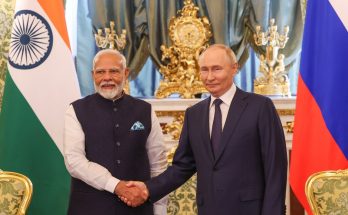
The much “Trump-eted” 2+2 moment in India-US relations is finally here. Amid a rapidly mutating geopolitical landscape in the Indo-Pacific region and a slew of global and regional hotspots vying for attention, the foreign and defence ministers of India and the US will meet in New Delhi on September 6 to firm up a new template for steering India-US partnership onto a higher trajectory.
A high point of diplomatic engagement between the world’s largest democracies, the inaugural 2+2 dialogue is expected to culminate in a host of substantive outcomes that will translate into greater US support for India’s rise as a major global power and bring the two countries into a tighter strategic embrace.
Mapping Next Steps
Building on the transformational nuclear deal, the 2+2 dialogue will map out the next big steps in “the defining partnership of the 21st century,” with enhanced defence and strategic collaboration emerging as the anchor-sheet of this growing relationship.
Clearly, there are high stakes for both sides as India’s External Affairs Minister Sushma Swaraj and Defence Minister Nirmala Sitharaman sit down for talks with their American counterparts, Secretary of State Mike Pompeo and Defence Secretary James Mattis in New Delhi. The four principals are expected to hold across-the-spectrum talks for around three hours, including a working lunch.
Enhancing Defence Partnership

Ahead of the 2+2 dialogue, the US has underscored that the overarching thrust will be on operationalizing India’s status as US Major Defence Partner, which was announced during the Obama administration in 2016 and was reaffirmed by President Trump during Modi’s visit to the US in July 2017. In the US’ view, bolstering India’s defence infrastructure is critical to its rise as a major global and regional player with a view to containing China’s alleged expansionism. This defence-focused approach can also be seen as an extension of President Donald Trump’s transactional diplomacy – US defence exports to India have risen to around $18 billion over the last decade. Ahead of the 2+2 dialogue, India has already cleared the procurement of 24 MRHs (multi-role helicopters) from the US. Put together, defence acquisitions worth around $5-8 billion are in the pipeline, which will entrench the US’ role as a leading supplier of cutting-edge weaponry.

India’s offset policy remains a source of concern for US defence majors investing in India, but the Modi government will like more India-US Make in India projects under the co-production and co-development model.
Besides defence acquisitions, the 2+2 dialogue will focus on fleshing out a slew of enabling instruments to move the India-US defence relationship to the next level. Many deliverables in the area of defence are expected, which could include a hotline between Indian and US ministers for defence and foreign affairs and posting of an Indian Navy liaison officer at the US Naval Forces Central Command (NAVCENT) in Bahrain.
Launching collaboration in defence innovation, a frontier area that encompasses artificial intelligence space, robotics and information technology, will be among important outcomes of the 2+2 dialogue. In this regard, the proposed collaboration between Indian Defence Innovation Organisation (DIO) and US Defense Innovation Unit Experimental (DIUx) in Mountain View, California, is expected to be institutionalised.
COMCASA Quandary
As India and the US raise the bar for their defence partnership, it’s not clear whether India will take a leap of faith and finally sign COMCASA. The draft text of COMCASA is ready, but awaits final approval from the Cabinet. The Indian side is pushing the US to include concrete assurances and guarantees in the draft agreement against intrusive inspections of the US-acquired equipment. The key concern for India is to ensure that the pact is not misused for spying on India or in any way which will compromise India’s sovereignty and vital security interests. Informed sources indicated that COMCASA may not be signed at the 2+2 dialogue, but the two sides could announce an in-principle approval to the crucial pact.
The extreme circumspection on the part of India regarding COMCASA is reminiscent of a thousand visions and revisions that marked the intensely polarizing debate around the 123 nuclear deal. However, to move the defence relationship to next level, the signing of COMCASA looks inevitable, sooner rather than later.
Navigating Iran & Russia sanctions

The primary focus at 2+2 talks, as Secretary Pompeo has said, will be on buttressing structure of the India-US bilateral relationship with new ideas and initiatives. But all eyes in India will be on two tricky issues that involve third countries. With barely a couple of months to go before the November 4 deadline for US sanctions and imports of Iranian oil, India will be looking to win US waiver. Given Iran’s importance for India’s energy security and strategic profile of Iran in the shifting geopolitical landscape in West Asia, India simply India simply can’t afford to stop importing Iranian oil altogether. It will also be in the interests of the US to find a way around the Iran impasse.
Similarly, India will be making a case for US waiver from CAATSA to purchase Russian S-400 missile system. Given the sensitivity of these issues, there may not be final resolutions, but enough hints and guesses by Mike Pompeo and Jim Mattis to make India happy. “They are (missile system purchase from Russia and oil from Iran) part of the conversation. They will certainly come up, but I don’t think they will be the primary focus of what it is we are trying to accomplish here,” Secretary Pompeo said ahead of the talks.
Going forward, the 2+2 dialogue will underscore the growing convergence between President Donald Trump’s foreign policy and India’s global aspirations, and help recalibrate the India-US partnership to achieve interlinked strategic goals, specially in the Indo-Pacific, which has become a zone of competing ambitions and conflicting perceptions.

Author Profile

- Manish Chand is Founder-CEO and Editor-in-Chief of India Writes Network (www.indiawrites.org) and India and World, a pioneering magazine focused on international affairs. He is CEO/Director of TGII Media Private Limited, an India-based media, publishing, research and consultancy company.
Latest entries
 India and the WorldJuly 9, 2024Defying West, India sets $100 billion trade target with Russia
India and the WorldJuly 9, 2024Defying West, India sets $100 billion trade target with Russia India and the WorldJuly 5, 2024India at SCO: Takes swipe at Pakistan for cross-border terror, pushes alternative to BRI
India and the WorldJuly 5, 2024India at SCO: Takes swipe at Pakistan for cross-border terror, pushes alternative to BRI India and the WorldJune 14, 2024Modi’s Day 1 in Italy: Bonding with Britain, France
India and the WorldJune 14, 2024Modi’s Day 1 in Italy: Bonding with Britain, France India and the WorldJune 13, 2024G7 summit in Italy: Modi to showcase India as leader of Global South
India and the WorldJune 13, 2024G7 summit in Italy: Modi to showcase India as leader of Global South






